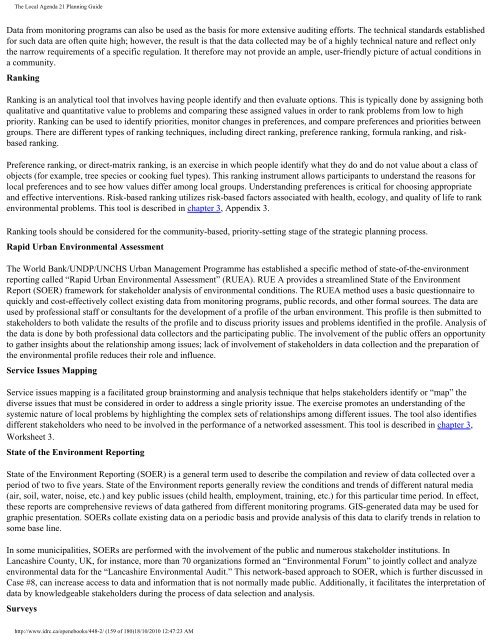The Local Agenda 21 Planning Guide - Democrats Against UN ...
The Local Agenda 21 Planning Guide - Democrats Against UN ...
The Local Agenda 21 Planning Guide - Democrats Against UN ...
You also want an ePaper? Increase the reach of your titles
YUMPU automatically turns print PDFs into web optimized ePapers that Google loves.
<strong>The</strong> <strong>Local</strong> <strong>Agenda</strong> <strong>21</strong> <strong>Planning</strong> <strong>Guide</strong><br />
Data from monitoring programs can also be used as the basis for more extensive auditing efforts. <strong>The</strong> technical standards established<br />
for such data are often quite high; however, the result is that the data collected may be of a highly technical nature and reflect only<br />
the narrow requirements of a specific regulation. It therefore may not provide an ample, user-friendly picture of actual conditions in<br />
a community.<br />
Ranking<br />
Ranking is an analytical tool that involves having people identify and then evaluate options. This is typically done by assigning both<br />
qualitative and quantitative value to problems and comparing these assigned values in order to rank problems from low to high<br />
priority. Ranking can be used to identify priorities, monitor changes in preferences, and compare preferences and priorities between<br />
groups. <strong>The</strong>re are different types of ranking techniques, including direct ranking, preference ranking, formula ranking, and riskbased<br />
ranking.<br />
Preference ranking, or direct-matrix ranking, is an exercise in which people identify what they do and do not value about a class of<br />
objects (for example, tree species or cooking fuel types). This ranking instrument allows participants to understand the reasons for<br />
local preferences and to see how values differ among local groups. Understanding preferences is critical for choosing appropriate<br />
and effective interventions. Risk-based ranking utilizes risk-based factors associated with health, ecology, and quality of life to rank<br />
environmental problems. This tool is described in chapter 3, Appendix 3.<br />
Ranking tools should be considered for the community-based, priority-setting stage of the strategic planning process.<br />
Rapid Urban Environmental Assessment<br />
<strong>The</strong> World Bank/<strong>UN</strong>DP/<strong>UN</strong>CHS Urban Management Programme has established a specific method of state-of-the-environment<br />
reporting called “Rapid Urban Environmental Assessment” (RUEA). RUE A provides a streamlined State of the Environment<br />
Report (SOER) framework for stakeholder analysis of environmental conditions. <strong>The</strong> RUEA method uses a basic questionnaire to<br />
quickly and cost-effectively collect existing data from monitoring programs, public records, and other formal sources. <strong>The</strong> data are<br />
used by professional staff or consultants for the development of a profile of the urban environment. This profile is then submitted to<br />
stakeholders to both validate the results of the profile and to discuss priority issues and problems identified in the profile. Analysis of<br />
the data is done by both professional data collectors and the participating public. <strong>The</strong> involvement of the public offers an opportunity<br />
to gather insights about the relationship among issues; lack of involvement of stakeholders in data collection and the preparation of<br />
the environmental profile reduces their role and influence.<br />
Service Issues Mapping<br />
Service issues mapping is a facilitated group brainstorming and analysis technique that helps stakeholders identify or “map” the<br />
diverse issues that must be considered in order to address a single priority issue. <strong>The</strong> exercise promotes an understanding of the<br />
systemic nature of local problems by highlighting the complex sets of relationships among different issues. <strong>The</strong> tool also identifies<br />
different stakeholders who need to be involved in the performance of a networked assessment. This tool is described in chapter 3,<br />
Worksheet 3.<br />
State of the Environment Reporting<br />
State of the Environment Reporting (SOER) is a general term used to describe the compilation and review of data collected over a<br />
period of two to five years. State of the Environment reports generally review the conditions and trends of different natural media<br />
(air, soil, water, noise, etc.) and key public issues (child health, employment, training, etc.) for this particular time period. In effect,<br />
these reports are comprehensive reviews of data gathered from different monitoring programs. GIS-generated data may be used for<br />
graphic presentation. SOERs collate existing data on a periodic basis and provide analysis of this data to clarify trends in relation to<br />
some base line.<br />
In some municipalities, SOERs are performed with the involvement of the public and numerous stakeholder institutions. In<br />
Lancashire County, UK, for instance, more than 70 organizations formed an “Environmental Forum” to jointly collect and analyze<br />
environmental data for the “Lancashire Environmental Audit.” This network-based approach to SOER, which is further discussed in<br />
Case #8, can increase access to data and information that is not normally made public. Additionally, it facilitates the interpretation of<br />
data by knowledgeable stakeholders during the process of data selection and analysis.<br />
Surveys<br />
http://www.idrc.ca/openebooks/448-2/ (159 of 180)18/10/2010 12:47:23 AM










